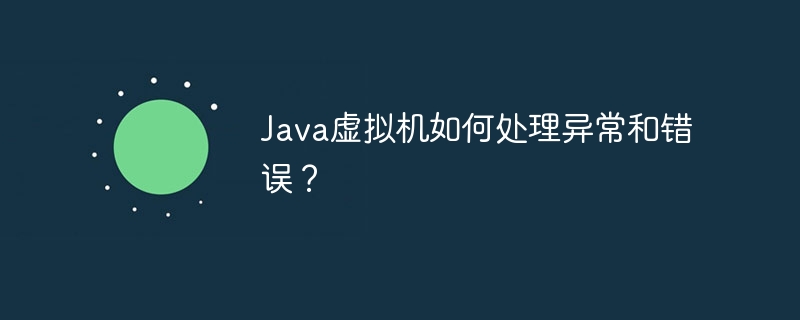Home >Java >javaTutorial >How does the Java virtual machine handle exceptions and errors?
How does the Java virtual machine handle exceptions and errors?
- WBOYOriginal
- 2024-04-13 13:51:02616browse
The Java Virtual Machine (JVM) handles exceptions and errors through the Error and Exception classes. Error represents a serious problem that the JVM cannot handle, while Exception represents a non-serious problem that can be recovered. The JVM uses try-catch blocks to handle exceptions. When an exception occurs, the program jumps to the catch block to execute the code.

Detailed explanation of Java virtual machine exceptions and error handling
Introduction
Java virtual machine Machine (JVM) is a virtual machine that runs Java bytecode. It is responsible for managing object creation, object memory allocation, and garbage collection. In addition to this, the JVM is also responsible for handling exceptions and errors.
Exceptions
Exceptions are errors that occur during program execution, but from which the program can recover. In Java, exceptions are subclasses of Throwable class, and Error class and Exception class are the two main subclasses of Throwable class.
- Error: Error indicates a serious problem that the JVM cannot handle, such as OutOfMemoryError or StackOverflowError. Error will cause the JVM to terminate.
-
Exception: Exceptions represent non-serious problems from which the program can recover. Exception can be divided into two types: checked exception (Checked Exception) and unchecked exception (Unchecked Exception).
- Checked exceptions must be declared in the method signature so that the caller can handle them.
- Unchecked exceptions do not need to be declared in the method signature, nor do they need to be handled by the caller.
Error handling
JVM can handle Error in the following two ways:
- Terminate JVM: For serious errors, the JVM will terminate immediately.
- Throw Error object: For less serious errors, the JVM will throw an Error object.
Exception handling
The JVM uses try-catch blocks to handle exceptions. The try block contains the code to try to execute. If an exception occurs during execution, the JVM will jump to the catch block and execute the code in the catch block. The parameters of the catch block must be a subclass of the Throwable class and can specify the specific exception type to be caught.
Practical case
The following is a practical case for handling exceptions:
public class ExceptionExample {
public static void main(String[] args) {
try {
int x = 10 / 0;
} catch (ArithmeticException e) {
System.out.println("An ArithmeticException occurred: " + e.getMessage());
}
}
}In this example, the code in the try block will generate an ArithmeticException exception . The JVM will jump to the catch block and print the exception message.
Conclusion
The JVM provides powerful exception and error handling mechanisms through the Error and Exception classes. By using the Error and Exception classes, programmers can handle exceptions and errors that occur in the program and ensure that the program can recover from exception situations or exit gracefully.
The above is the detailed content of How does the Java virtual machine handle exceptions and errors?. For more information, please follow other related articles on the PHP Chinese website!

